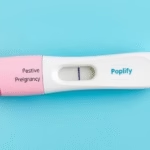Understanding Implantation Bleeding
When a fertilized egg attaches itself to the lining of the uterus, it may cause slight bleeding, referred to as implantation bleeding. This occurs typically around 6 to 12 days after conception, although the timing may vary. Many women mistake this early sign of pregnancy for a light menstrual period. Recognizing the difference is crucial when trying to conceive.
Implantation bleeding is usually light pink or brown in color, as opposed to the bright red of menstrual bleeding. It is often less intense and lasts for a shorter duration—usually just a few hours to a couple of days. Understanding when to test after implantation bleeding stops is vital for those in their reproductive journey, as this might indicate an optimal time to accurately confirm pregnancy through a home pregnancy test.
When Should You Test After Implantation Bleeding?
After experiencing implantation bleeding, many women wonder about the best time to take a pregnancy test. It is generally recommended to wait at least until the day your expected period is due.
The reason for this timing is linked to the hormone human chorionic gonadotropin (hCG). After implantation, the body begins to produce hCG, and it takes some time for levels to rise enough to be detected by most home pregnancy tests. Testing too early may yield a false-negative result, leading to unnecessary disappointment.
For most women, waiting about a week after implantation bleeding stops before taking a test can provide a more accurate indication of pregnancy.
Timing is Key: Why Wait for Testing
The timing of testing after implantation bleeding stops is crucial. One reason is the hormone hCG, which starts to rise shortly after implantation. However, the levels can vary from woman to woman, meaning that while some may detect a pregnancy shortly after the bleeding stops, others may take longer.
Generally, it is best to wait until around the time of your expected period, which typically gives enough time for hCG levels to increase. Testing too early may result in a false negative, as the test may not be sensitive enough to detect low amounts of the hormone.
Benefits of Waiting to Test:
- Improved accuracy of test results.
- Avoidance of emotional disappointment from false negatives.
- Having a better understanding of your menstrual cycle and ovulation.
Recognizing Symptoms After Implantation Bleeding
After implantation bleeding, many women report a variety of symptoms. These are typically associated with early pregnancy and can guide you in the decision of when to test.
Common Symptoms Include:
- Light cramping.
- Breast tenderness.
- Fatigue.
- Morning sickness, albeit not everyone experiences this.
- Changes in appetite.
Being aware of these symptoms can help you decide how soon to test. It is important, however, to remember that each individual is unique, and experiences can vary significantly.
Understanding the Pregnancy Test
Most home pregnancy tests work by detecting the presence of hCG in your urine. They are generally quite accurate when used correctly, but there are a few factors that can affect the results.
Timing, as discussed, plays a major role. Additionally, using the test first thing in the morning can yield a more reliable result, as urine is more concentrated at this time. It is important to read the instructions carefully to ensure the most accurate outcome.
In cases of uncertainty, or if you test negative but still believe you may be pregnant, consulting with a healthcare professional can provide clarity and guidance.
The Role of Hormones in Early Pregnancy
After implantation, the body undergoes numerous hormonal changes. These hormones are pivotal for sustaining pregnancy and preparing the body for the growth and development of the fetus.
hCG is the first hormone produced, and its levels can be indicative of pregnancy. Other hormones, such as progesterone, play critical roles in maintaining the uterine lining, which is essential for a successful pregnancy.
Understanding the role of these hormones can help women better interpret their bodies’ signals following implantation bleeding.
Common Misconceptions About Implantation Bleeding
There are several misconceptions surrounding implantation bleeding. One of the most common is that it is the same as a menstrual period. However, implantation bleeding is typically lighter, shorter, and not accompanied by the symptoms that may accompany menstruation, such as significant cramping or mood swings.
Another misconception is that all women will experience implantation bleeding when they conceive. In fact, many do not notice any bleeding at all.
Understanding these misconceptions can help women demystify the early signs of pregnancy and approach testing with a clearer mindset.
Psychological Effects of Early Pregnancy Testing
The decision to test early can have psychological implications. Those trying to conceive may experience significant stress and anxiety around the testing process. A false negative can lead to feelings of disappointment and discouragement.
It is essential to approach testing with the understanding that early pregnancy can be unpredictable, and waiting might reduce some of the emotional turmoil.
Additionally, having a support system in place—whether through friends, family, or online communities—can help ease the mind through this often anxious time.
Final Thoughts
Understanding when to test after implantation bleeding stops is crucial for women navigating the early stages of pregnancy. The window of time between experiencing implantation bleeding and taking a pregnancy test can significantly influence the accuracy of the test results.
By paying attention to symptoms and hormonal changes, women can better prepare themselves for when to take a test. As discussed, factors such as timing, testing methods, and common misconceptions play key roles in this process. Remember, it’s perfectly normal to feel anxious or uncertain during this time. Seeking support and information can provide clarity.
If you suspect you might be pregnant, wait a few days after implantation bleeding has stopped before taking a test to give your body ample time to produce detectable levels of hCG. Armed with knowledge about the various stages of early pregnancy, you can approach the testing process with confidence and understanding.
Frequently Asked Questions
1. What does implantation bleeding look like?
Implantation bleeding typically appears as light pink or brown spots. It is much lighter than a normal menstrual period and is usually shorter in duration.
2. How long does implantation bleeding last?
Implantation bleeding generally lasts a few hours to a couple of days. If bleeding continues or becomes heavy, it is advisable to consult with a healthcare professional.
3. Can I take a pregnancy test immediately after implantation bleeding?
It is recommended to wait until the day your period is due for the most accurate result, as hCG levels need time to rise after implantation.
4. What should I do if I test negative after implantation bleeding?
If you test negative but still suspect pregnancy, wait a few days and retest. If uncertainty persists, a visit to a healthcare provider is recommended.
5. Is implantation bleeding common?
Many women do not experience implantation bleeding, and it is perfectly normal. Only about one-third of women may notice it during early pregnancy.
Further Reading
What Type of Psychotherapy Is Best for Anxiety?







